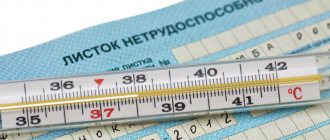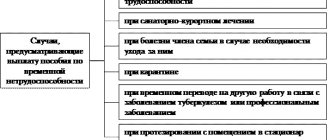Estimated periods of disability according to ICD-10 for injuries
_______________ * Employment required depending on working conditions.
Primary biliary cirrhosis
Secondary biliary cirrhosis
Portal liver cirrhosis
_______________ ** Referral to ITU is possible, taking into account working conditions.
Neglected and recurrent bile duct stones
Inflammatory stricture of the bile ducts
Iatrogenic damage to the bile ducts
_______________ ** Referral to ITU is possible, taking into account working conditions.
https://youtu.be/s-PUk2wjiOQ
Estimated periods of disability according to ICD 10
Approximate periods of temporary disability for respiratory diseases
Approximate terms of temporary disability for diseases of the digestive system
Approximate periods of temporary disability for diseases of the skin and subcutaneous tissue
Estimated periods of temporary disability for diseases of the musculoskeletal system and connective tissue
This is important to know: Temporary disability certificate (sample form)
Estimated periods of temporary disability for diseases of the genitourinary system
Estimated periods of temporary disability during pregnancy, childbirth and the postpartum period
Approximate periods of temporary disability for injuries, poisoning and other consequences of external causes
Order of the Ministry of Health of the Russian Federation of June 29, 2011
Estimated periods of disability according to ICD-10 gynecology
Each nosological form of the disease has two codes: one corresponds to the “International Statistical Classification of Diseases and Related Health Problems”, tenth revision (ICD-10), the second corresponds to the line number of the statistical form N 16-VN “Information on the causes of temporary disability”, approved by the resolution State Statistics Committee of Russia dated June 29, 1999 N 49. For many nosological forms, the approximate periods of temporary disability are given taking into account the characteristics of the clinical course of the disease, the degree or stage of the disease, and the type of treatment (conservative or surgical). Approximate time frames for injuries and poisonings are determined taking into account the level and location of the injury, its nature and severity.
Decor
By order of the Ministry of Health and Social Development “On the procedure for issuing certificates of incapacity for work” dated June 29, 2011 No. 624n (section 2), a domestic injury that requires treatment and absence from the workplace is issued in accordance with the general rules.
If an injury occurs at home, the victim must go to the emergency room or call an ambulance, which will take the patient to the emergency room or hospital. Or you can come to an appointment with a doctor, who is required to issue a bulletin on the first day of the injury. The household injury code indicated on the form is 02.
To obtain a sick leave certificate, the following documents are required:
- passport;
- compulsory medical insurance policy;
- pension insurance certificate.
Maximum and minimum periods of incapacity for work
The duration of sick leave depends on the reason for receiving it. The document is issued by the attending doctor. The doctor determines the closing date of the ballot as the citizen’s health improves.
The duration of the certificate of incapacity for work depends on the following factors:
- type of disease;
- presence of complications;
- the severity of the patient's condition.
The minimum period of incapacity for work is three days, the maximum is six months. For complex illnesses or serious injuries, the period increases to one year.
What determines the length of sick leave?
Doctors have the right to independently decide on extending sick leave. For example, dentists and paramedics extend their ballot no longer than ten days. After the designated period, the patient is sent to a medical examination, which decides whether to extend or close the sick leave.
The duration of a person’s stay on sick leave is regulated by Order of the Ministry of Health No. 624n. If, after completing the therapeutic course, the citizen’s health does not improve and it is no longer possible to extend the sick leave, the person is sent to the VTEK (medical labor expert commission) to establish disability. The date a person is recognized as disabled is considered the moment the certificate of incapacity for work is closed.
ATTENTION! If the indicators for assigning a disability group to a citizen are not enough, the ballot is extended until health is fully restored. At the end of the repeat period, the patient is sent to VTEC.
The duration of inpatient therapy has not been established, since the doctor cannot predict the patient’s course of recovery. In such situations, a certificate of incapacity for work is issued for the entire period of the citizen’s stay in the hospital. If surgical intervention is necessary, the length of hospital stay increases.
The day hospital does not provide for the patient's 24-hour stay in the hospital. But the employee attends medical procedures or undergoes a course of injections. In such situations, a bulletin is issued for the period the person undergoes recovery procedures. If, for example, ten droppers are required, a certificate of incapacity for work is issued for 10 days.
IMPORTANT! Complex diagnostic procedures that are carried out on an outpatient basis require the issuance of a sick leave certificate for the dates of treatment (intermittent sick leave).
How is sick leave issued?
A sick leave is opened by a doctor on the first day of illness. The corresponding code is indicated on the form (02 - injury)
To refuse to issue a certificate of incapacity for work there must be a very compelling reason. The list is not that long:
- registration retroactively or in advance;
- the patient’s behavior interferes with the activities of the medical institution;
- Upon examination, no signs of injury were revealed.
How is it paid?
To calculate sick leave pay for a specific employee’s domestic injury, his length of service, salary and all payments that were made over the last two years are taken into account.
Moreover, we are talking specifically about labor payments - this includes, for example, bonuses.
Sick leave should not be taken into account.
Amount of total income (x)
number of days worked (y)
X/Y = average citizen's earnings (Z)
Z multiplied by the number of days of sick leave = amount of compensation.
Important: Z must be compared with the minimum wage - it will turn out to be more or less. Turned out to be smaller? Then the minimum wage is taken for calculation (FSS Letter No. 14-03-18/05-2129 dated March 11, 2011).
If an employee’s work experience is at least eight years, he is paid compensation in the amount of one hundred percent of his earnings.
Also, when calculating, they proceed from the notorious minimum size if:
- the injury was caused by alcohol intoxication or exposure to toxic substances;
- violation of hospital regulations;
- a person did not show up for an appointment without a good reason.
Injury is an unpleasant issue for both the victim and the employer. When applying for sick leave, the first priority should not be the ability to go to work as quickly as possible, but how much is required for real recovery.
Now you know how sick leave is paid if there is a domestic injury. Be careful!
Approximate terms of temporary disability according to ICD-10
In accordance with the International Classification of Diseases, 10th revision, the following approximate periods of sick leave are assumed for the most common diseases:
| Reason for issuing the ballot | Duration of disability |
| Acute respiratory viral disease | From five days to two weeks. |
| Angina | 10–15 days. |
| Concussion | 10–120 days, depending on the severity of the concussion. |
| Oncology | Initially, the ballot is issued for 120 days. If necessary, the patient is sent to MSE (medical and social examination) to increase the period of the bulletin. |
| Tuberculosis | From four to ten months. |
| Appendectomy | From 16 to 21 days. |
| Performing a hysterectomy | 65–100 days. |
| Carrying out cholecystectomy | 48–55 days. |
| Cyst removal | From 20 to 28 days. |
| Removal of a tooth | From three to ten days. |
| Heart attack | The minimum period of sick leave is 60 days, the maximum is 90. |
ATTENTION! The periods of temporary disability in accordance with the International Classification of Diseases, 10th revision are indicated approximately. The final decision on the duration of the bulletin is made by the doctor on the basis of Order of the Ministry of Health No. 624n.
Sick leave codes and their decoding according to the ICD, causes of disability
The World Health Society has developed a special coding system for medical diagnoses, which is used in medical regulations for standardization purposes. In 2011, a standard form was approved and the requirements for filling out sick leave were changed, in which some of the information was encrypted into codes, including the cause of temporary disability.
This not only saved space on the document, but also made it possible to hide medical data from prying eyes. The main sick leave codes and their interpretation will be discussed below.
Functional meaning of codes
Disease codes are used in hospital records not only for practical purposes to simplify filling out the form - they have important functional significance:
- Maintain medical confidentiality;
- They standardize the work of the organization’s accounting department, which calculates the amount of insurance payment based on the disease code;
- They allow you to reach an international level of work - even if the treatment was carried out abroad, the ICD diagnosis code is the same in all WHO member countries.
The coding system made it possible to optimize the collection and analysis of statistical information. It is especially necessary to identify the acceptable threshold of morbidity during epidemics, as well as to determine the mortality rate from a specific disease.
Rules for filling out sick leave
For sick leave, by order of the Ministry of Health and Social Development No. 624n, rules for filling out have been developed, failure to comply with which entails the invalidity of the document. Data is entered in Russian in large block letters in black ink or printed in machine text. You cannot go beyond the boundaries of the cells. Letters and numbers must be legible so that electronic scanning can recognize them.
Corrections by medical staff are not allowed; in case of an error, you will have to use a new sick leave form. If the cause of disability suddenly changes, the corresponding “changed code” column is filled in.
Classification according to ICD
Disability codes are placed on the sick leave to indicate the cause and nature of the disease, which affect the amount of payment.
To fill out sick leave, they use the national code of the cause of disability with a two-digit or three-digit designation, as well as the international diagnosis system ICD 10. This is the latest version of the classification of diseases, which includes 21 sections.
Each section is divided into general blocks of diagnoses. ICD codes are alphanumeric, such as B99 or V01.
National disease codes are divided into basic and additional. The main group includes 15 two-digit numbers that indicate a general characteristic of the disease without specifics.
Basic codes
These include:
- 01 – General disease (used more often than others);
- 02 – Injury received at home;
- 03 – Quarantine (necessary during times of risk of infectious diseases);
- 04 – Injury that occurred at work during the performance of work duties;
- 05 – Disability related to pregnancy and childbirth;
- 06 – Complex prosthetics, which are only permissible with inpatient supervision;
- 07 – Onset or exacerbation of an occupational disease;
- 08 – Sanatorium treatment;
- 09 – The need to care for a sick family member or relative;
- 10 – Other dangerous conditions;
- 11 – A disease that is significant for society (tuberculosis, oncology, HIV, etc.);
- 12 – Caring for a child under 7 years of age who has a disease with systemic damage to organs or vital functions of the body;
- 13- Caring for a disabled child;
- 14 – Illness of a child that is associated with a post-vaccination complication or oncology;
- 15 – HIV infection in a child.
The last two codes are indicated when filling out sick leave only with the consent of the child’s parent.
Additional designations
Auxiliary three-digit codes are not often indicated on sick leave. They provide additional information that affects the calculation of temporary disability benefits. There are five such designations:
- 017 – indicated for sanatorium treatment;
- 018 – sanatorium and preventive treatment in connection with injury at work;
- 019 – inpatient treatment in research institutes or clinics;
- 020 – paid maternity leave;
- 021 - indicates if the diagnosis or injury was provoked by intoxication with alcohol or drugs.
If such information is not required, then the line “add. code" simply remains blank. The sick leave form has a column “other”, where important information is also indicated:
- Code 31 - indicated when the illness continues to close the old one and open a new one;
- 32 – means assignment of a disability group;
- 33 – change of disability group;
- 34 – death of the patient;
- 35 – indicated when refusing a medical examination;
- 36 – the patient is recognized as able to work (if the employee fails to appear, absenteeism will be considered);
- 37 – sent for home treatment after hospitalization.
Terms of temporary disability for injuries
List of the most common injuries with approximate periods of sick leave:
- In case of a broken limb, sick leave is issued for one or two months.
- In case of damage to the spinal column, a bulletin is issued for 60–240 days, depending on the location of the fracture and the presence of displacement.
- Penetrating trauma to the orbit requires one to two months of treatment.
- An open wrist injury results in a minimum of two weeks of disability with a maximum recovery period of one month.
- An open wound to the scalp will leave you unable to work for 7–25 days, depending on the severity of the injury.
- After a rib fracture, the employee will return to work within two to four weeks.
- After a fracture of the lower jaw, the employee’s rehabilitation will take from 28 to 45 days.
The average period of temporary disability for injuries depends on the type of injury, the presence or absence of complications. The bulletin includes a complete recovery period for the functionality of the damaged body part.
What is traumatic injury?
Classification
As already mentioned, this is any injury that a person received outside of work.
There is no doubt that every case must be investigated and reliably established.
The investigation is initiated by the director and a corresponding order is issued.
The victim himself must participate in the procedure, and if this is not possible, his official authorized representative.
Based on the results of such an inspection, a special act is drawn up.
How to distinguish a work-related injury from a domestic injury is another question. The latter is in no way connected specifically with the work process, even if it was received in the building where the citizen’s place of work is located.
For example, during a corporate event an incident may occur and the employee will be forced to visit a doctor. The injury he received in this way will still be considered domestic.
Not everything is clear with a company car. If an employee is injured while driving, it will not be considered work-related if the following factors are present:
- the machine was not used for work and without a written assignment from the director;
- the company does not issue waybills;
- A company car is not provided for under the employment contract at all.
Damage received during, say, lunch, will be regarded as production-related, although it does not seem to be related to the production process. True, everything also depends on the company’s charter - if smoking was prohibited by it, and the employee “acquired” an injury during a smoking break, then it will be considered domestic.
Worth knowing! If, as a result of an incident, a citizen cannot go to work and perform official duties, a sick leave certificate is issued.
In the case of a minor injury, when a person can still go to work, for example with a cane, sick leave is not issued, the person is simply given a certificate of attendance at the emergency room.
The duration of sick leave for a domestic injury may vary. This will depend on the nature of the damage and what treatment is required. But you need to take into account that the upper limit of any sick leave is three weeks, and it can be extended further with the participation of a medical commission.
To open a sick leave for a domestic injury, you need to consider injuries of varying severity (as well as write what injuries are usually received in everyday life) and write for how long a sick leave is opened for a domestic injury at the initial visit and for how long the sick leave can be extended with a particular injury.
In addition, you may be interested in the following topics regarding sick leave:
Broken arm
Sick leave for a broken arm depends on the specific individual case and is determined by the traumatologist. Sick leave for a fracture is issued first for ten days, and then, by decision of the MSEC, the period of sick leave for a fracture is extended to thirty.
The victim can continuously “ballot” for one hundred and twenty days, then - the verdict of the medical and social expert commission: leave for a maximum of the same amount, discharge, or assign the status of a disabled person.
Here everything depends on the severity of the injury and the prognosis. Usually the standard four months - and for MSEC. Then they decide.
If the prognosis is unfavorable, the person is assigned a disability group.
If there is a gradual improvement and the patient is able to work (for example, his work is related to office conditions), sick leave for a fracture can be extended for a maximum of ten months.
Coccyx fracture
Everything depends on the maximum four-month “ceiling” and the decision of the MSEC. For how many days of sick leave is given for a fractured tailbone, aggravating factors and the doctors’ prognosis play a role.
Concussion
In the mild and moderate variants, the patient takes sick leave for ten to twenty-five days. In more severe cases, everything will depend on the nature of the injury, the stage of the process, the severity of dysfunction, the course of the disease, compensatory capabilities, and also on the nature and working conditions.
It depends on the degree and location of the burn, how long ago the injury was, and whether there is a need for hospitalization.
Depends on the degree of cut and blood loss, but no more than thirty days (Order of the Ministry of Health and Medical Industry of the Russian Federation No. 206).








